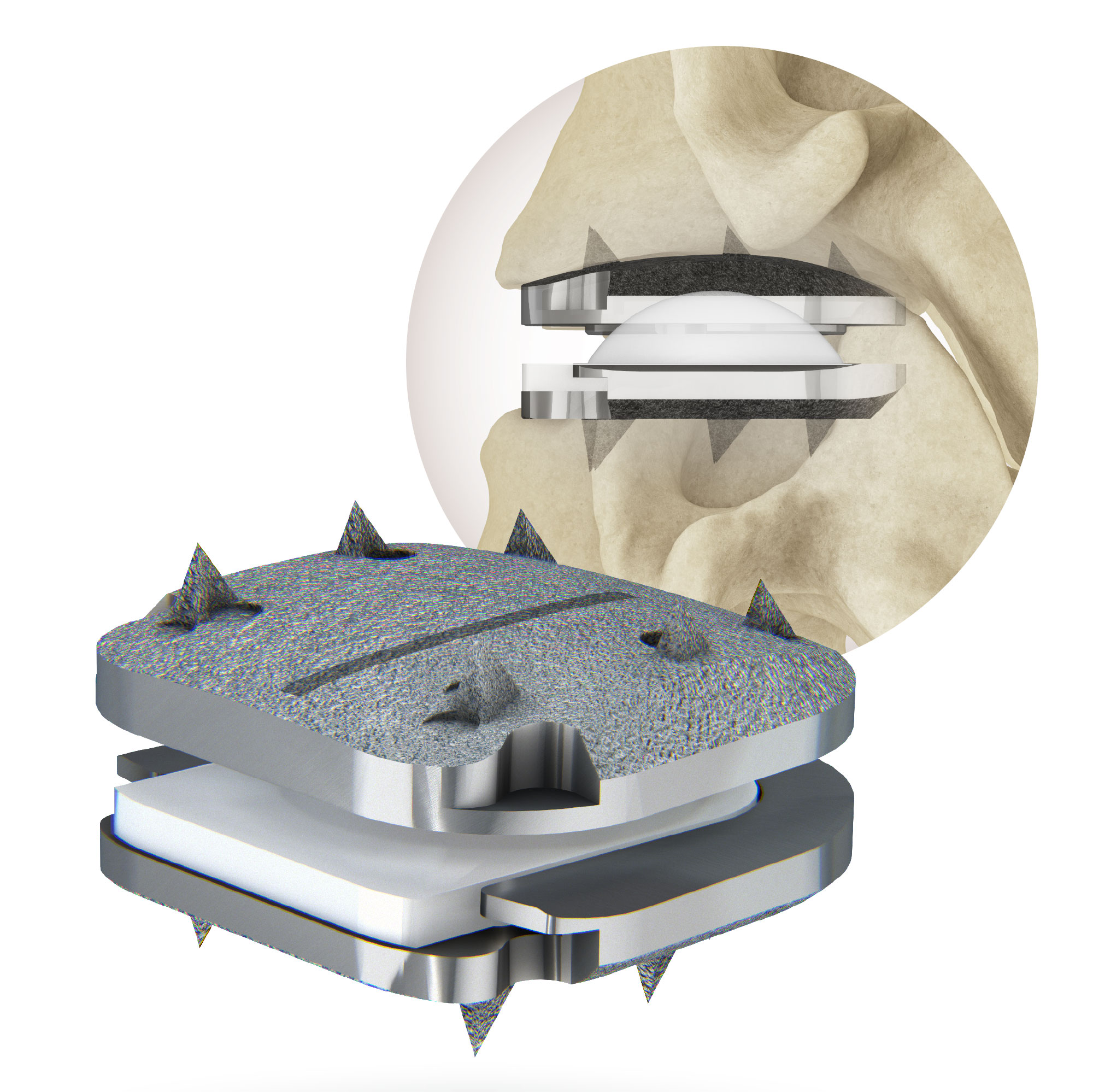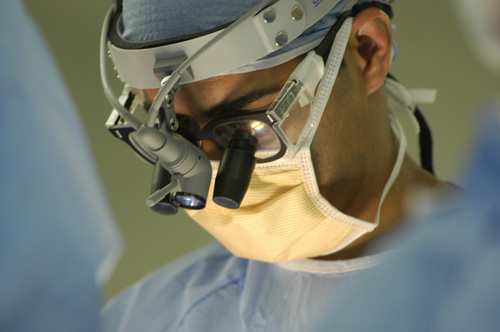 Artificial Disc for the Neck
Artificial Disc for the Neck
Centinel Prodisc-C VIVO Artificial Disc Replacement
 The treatment goal of the prodisc C Total Disc Replacement is to restore the normal dynamic function of the spine and to significantly reduce pain.
The treatment goal of the prodisc C Total Disc Replacement is to restore the normal dynamic function of the spine and to significantly reduce pain.
The function of the spine is restored through the mechanism of action of the device. Pain reduction is achieved through the re-establishment of the disc height, and maintained by the prosthesis. The increase in height and the elimination of the herniated disc “opens” constricted nerve paths and the vertebral joints are restored to their physiological position.
Prior to the development of artificial discs the only surgical option was a fusion, in which adjacent vertebral bodies are “fused together” permanently using implants, bone chips and/or cages. The goal of prodisc C is to maintain mobility at the affected intervertebral disc and to reduce the extra loading on the adjacent intervertebral discs.
Interested patients can learn more about new artificial disc replacement options by calling 972-741-7189.
About Prodisc
 Prodiscis a Total Disc Replacement (TDR) technology platform that offers a surgical treatmentproven to maintain spinal balance and motion, decelerate adjacent level reoperations and accelerate the return to normal activities. Centinel Spine is currently the only company in the United States to offer Total Disc Replacement devices for both the cervical and lumbar spine.
Prodiscis a Total Disc Replacement (TDR) technology platform that offers a surgical treatmentproven to maintain spinal balance and motion, decelerate adjacent level reoperations and accelerate the return to normal activities. Centinel Spine is currently the only company in the United States to offer Total Disc Replacement devices for both the cervical and lumbar spine.
Mechanism of Action
The prodiscimplantis a ball and socket design with a fixed center of rotation. This patented design has been in clinical use since 1990 and utilized across the entire product platform. Thefixed center of rotation allows physiological range of motion while providing stability to the spineand significantly reducingreoperations at the adjacent levels.
 Immediate Fixation
Immediate Fixation
Immediate post-operativefixation is provided by themidline keels, ensuring the implant is securely held in place sothe patient can begin rehabilitation and returnto their normal activitiesas soon as possible.
Long term Fixation
The entire surface of the implant that is in contact with the vertebra is coated with a highly porous plasma sprayed titanium coating. This allows for bony on-growth into the porous surface of the implant for long term,secure fixation.
An Alternative to Fusion Surgery
The artificial disc concept is intended to be an alternative for spinal fusion surgery. Each year in the U.S., more than 200,000 spinal fusion surgeries are performed to relieve excruciating pain caused by damaged discs in the low back and neck areas.
 During a fusion procedure, the damaged disc is typically replaced with bone from a patient’s hip or from a bone bank. Fusion surgery causes two vertebrae to become locked in place, putting additional stress on discs above and below the fusion site, which restricts movement and can lead to further disc herniation with the discs above and below the degenerated disc. An artificial disc replacement is intended to duplicate the function level of a normal, healthy disc and retain motion in the spine.
During a fusion procedure, the damaged disc is typically replaced with bone from a patient’s hip or from a bone bank. Fusion surgery causes two vertebrae to become locked in place, putting additional stress on discs above and below the fusion site, which restricts movement and can lead to further disc herniation with the discs above and below the degenerated disc. An artificial disc replacement is intended to duplicate the function level of a normal, healthy disc and retain motion in the spine.
When a natural disc herniates or becomes badly degenerated, it loses its shock-absorbing ability, which can narrow the space between vertebrae. In fusion surgery, the damaged disc isn’t repaired but rather is removed and replaced with bone that restores the space between the vertebrae. However, this bone locks the vertebrae into place, which can then damage other discs above and below.
A common aspect of all artificial discs is that they are designed to retain the natural movement in the spine by duplicating the rotational function of the discs Mother Nature gave us at birth. Most artificial disc designs have plates that attach to the vertebrae and a rotational component that fits between these fixation plates. These components are typically designed to withstand stress and rotational forces over long periods of time. Still, like any manmade material, they can be affected by wear and tear.
prodisc Patient Stories: Five-Time PGA Tour Winner Brian Gay from Centinel Spine on Vimeo.
Benefits
Some of the main benefits of the artificial disc parallel that of knee replacement and hip replacement. This can include the following benefits:
- An artificial disc in the neck or back, in principle, is designed to retain motion in that particular segment of the spine.
- It prevents degeneration of disc levels above and below the affected disc
- There is no bone graft required
- There can be a quicker recovery and return to work or activity
- It can be a less invasive and less painful surgery than a fusion
- There can be less blood loss during surgery
Lumbar vs. Cervical Artificial Discs
 Because of the weight of the body and the rotational stress that the trunk places on discs in the low back (lumbar) area, more stress is placed on artificial discs in the lumbar area than in the neck (cervical) area, which only supports the weight of the head.
Because of the weight of the body and the rotational stress that the trunk places on discs in the low back (lumbar) area, more stress is placed on artificial discs in the lumbar area than in the neck (cervical) area, which only supports the weight of the head.
A second issue relates to the ease of the artificial disc surgery and any necessary revision surgery to replace a worn out artificial disc. Because the surgeon must access the front of the spine, an incision is made in the abdomen for lumbar discs and in the front of the neck for cervical discs. Generally speaking, many spine surgeons believe access to the cervical discs can be easier than the lumbar discs.
Other issues to consider
When treating knee and hip replacement patients, orthopedic surgeons try to postpone the implantation of an artificial joint until a patient is at least 50 years old so that they do not outlive their artificial joint, which typically lasts anywhere from 15 to 20 years. Revision surgery, which may be necessary to replace a worn-out artificial joint, can be complex.
This is also a concern with the artificial disc. Unlike knee and hip replacement patients who are typically in their 50s or 60s, many patients can benefit from artificial disc technology at a much younger age — in their 20s or 30s. Therefore, the implantation of an artificial disc in younger patients can raise a surgeon’s concern about the potential life span of the artificial disc in the spine and the need for revision surgery to replace a worn-out artificial disc, which can be complex.
In summary, some spine surgeons may be cautious about the use of artificial discs for the following reasons:
- Wear and tear on artificial joints can require revision surgery in 10 to 20 years that can be extremely complex.
- Most artificial disc implants only address rotational forces, not the up and down shock absorbing function of the natural disc.
- Overweight people can wear out a lumbar disc prematurely.
- New artificial discs are continually in development, however FDA approval is a lengthy process.
- There are not many 20-year-long studies that show the long-term effects of wear and tear on artificial disc implants.
Generally, the technology is very promising. Your spine surgeon can provide information if your problem can be addressed with this technology.

Spine Physicians Institute treats back pain, neck pain, herniated discs, stenosis and other spine problems. Patients come to the spine center from across the Dallas-Fort Worth metroplex. Dr. Sethuraman is one of few Mayo Clinic fellowship-trained spine surgeons in the North Texas area. A fellowship is the highest level of medical education in the U.S.
